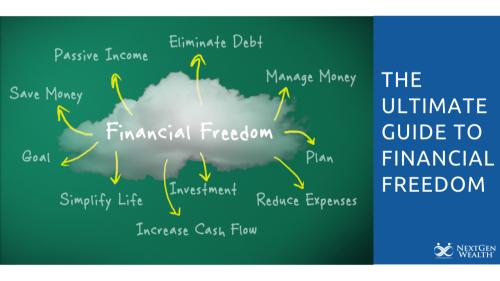The Ultimate Guide To Financial Freedom
By now, you’ve probably heard of the FIRE movement. FIRE, which stands for Financial Independence, Retire Early, is everywhere. As a matter of fact, there is even a new movie coming out called Playing With Fire. The film itself documents a young family’s journey into the FIRE subculture as they look for a way to cut down time spent working versus time spent with their family.
Financial freedom is a term used loosely, along with financial independence, and while they are very similar, they aren’t quite the same. The difference? Financial freedom allows you to completely walk away from your career without owing anyone a thing.
Financial independence can mean the same thing but people are usually considered financially independent as long as their income can be covered without relying on a traditional employer.
For the sake of our time, I’ll be sharing with you what I think is the ultimate guide to financial freedom. I want you to be able to live life on your terms without ever having to work again and, in a sense, be truly free. By following these steps, you’ll be on your way to living the life you’ve always wanted.
Prep Your Mindset
Even if you aren’t into the “woo woo” beliefs of “The Secret” or the “Law of Attraction”, preparing your mindset is the first step towards financial freedom. Mahatma Gandhi is famous for quoting “Your thoughts become your beliefs,” and I totally agree. This is also how an inaccurate money script can wreck your early retirement before you can even start.
Before you had even realized it growing up, you had feelings towards money based on your environment. This is due to actions you saw on behalf of others such as your parents or things that you actually experienced.
People believe all sorts of things about money, which, of course, has no feelings itself. Money is just money, people make it out to mean what they want it to mean based on their emotions.
So, if you have negative emotions regarding money, it’s going to hinder you. Scott Jeffrey goes into the importance of negative emotions about money and how important it is to change your script.
When you start out on your journey to financial freedom, you need to fully believe in it. Your thoughts are going to inspire your actions and you need your actions to align with your financial goals.
Your beliefs need to be strong because, let’s face it, change can make us feel uncomfortable. If you aren’t standing on a strong foundation, it can be rocked and that’s the last thing you’ll need when getting started.
Take A Financial Snapshot
Once you’ve decided to commit, the planning towards financial freedom can really begin. The next step in your plan is to take a financial snapshot to find out three things:
- Where you stand financially.
- Where your money is going.
- How much do you really need to cover your expenses?
If you’ve never calculated your net worth, this part may be scary but it’s definitely needed before we move to the next steps. We need to see your assets along with your debts to know where you stand.
There’s no way you can come up with an accurate plan without knowing exactly where you’re at currently. This includes knowing your income, expenses, assets and liabilities.
Don’t be ashamed if your net worth is low or even negative. You’re taking accurate steps now towards your future so it will only get brighter from here on out.
Along with not feeling ashamed of your net worth, try not to feel the same way when you realize where your money is or isn’t going every month. Tracking your expenses – having a budget – is the fastest way to see where your money is going and for some, it’s the fastest way to become discouraged.
As we mentioned earlier in step one, money doesn’t have feelings. Money is currency and we are the ones who are emotional about it. Don’t let it get you angry or upset.
Once you’ve tracked your expenses for a month to see where your money is going, multiply this by 12 to see the amount of income you need for a year to sustain your current lifestyle. If it exceeds your income or just meets it, you may want to look and see how you can lower your expenses.
The lower you can get your expenses, the easier financial freedom will be to achieve. But, if you’re not covering your expenses to begin with, you have a bigger problem on your hands to deal with first.
Figure Out The 4% Rule
Created by financial advisor William Bengen, the 4% rule is a common approach to finding out how much you need to have saved to create enough income to live off of during retirement. In a sense, this is the amount you need to generate in order to be financially free and live life on your terms, without dipping into principal on a regular basis.
If your yearly expenses are $60,000, then you would need $1,500,000 according to the 4% rule. It wouldn’t be realistic to not account for inflation, emergencies or just a change of lifestyle as you get older, so it’s wise to save as much as you can.
If nothing changes, you’ll just have a bigger cash cushion to play with. To figure out what you’ll need, take the amount of your yearly expenses – or what you need to live off of – and multiply it by 25. That should give you your estimated amount to be “financially free,” according to the 4% rule.
Note, the 4% concept is only a general rule of thumb. Only you can decide the amount of money you feel comfortable with that would allow you to be financially independent.
If you’re just getting started on your path to financial freedom, you’ll be changing your mind as you grow in your journey. But for now, use this as a base number to get started.
Decide Your Timeline
Now that you’ve come to a realistic amount in regards to what you should have saved to draw 4%, you now need to decide your timeline towards financial freedom.
Basically, your timeline can be determined two ways.
- When do you believe you can acquire the savings above to withdraw the 4%?
- When would you like to stop working?
Some people think it has to be one or the other but it certainly can be a hybrid of both. If financial freedom seems like a pipe dream and you’ll never be able to get there once you see the numbers, you won’t have much motivation. This is why a wealth mindset, which we mentioned in step one, is so important.
Acquiring wealth takes hard work. It’s not for the faint of heart. You’re going to have to get comfortable with being uncomfortable sometimes.
But if you are already reading this article, I’m going to take it as a sign that you do want it bad enough. You just have to get started.
Get Ready To Learn
Realizing the amount of money you need to have invested before you can consider yourself “financially free” may seem overwhelming. It may especially seem overwhelming once you’ve added the timeline in which you’d like to start living life on your own terms.
However, there are quicker ways to achieve financial freedom than just investing in the stock market. It’s about recognizing what you need to do in order to free up or create the income streams to get there.
Start learning as much as you can about how other people achieved financial independence. Take what they did and apply it to you and your situation. Make note of concepts or ideas you wish to come back to later.
Jot down the things you can control and focus on those to get started. You gain momentum by taking action, but you keep it by having something to work towards.
You may realize you need to take care of your debt first before you can start any type of investing. Start researching all you can about paying off debt. Look into different types of techniques and go with the one that seems the most sustainable.
Cut expenses and earn more money to put towards your debt. Once it’s paid off, redirect those funds into some type of investment account.
Learn about how to get started investing your money and the best way to do it. For example, if it’s real estate, start learning everything you can about it as an investment.
Research up and coming areas in your city, look into homebuyer assistance programs and analyze trends in the local market. If you already own, see if an investment property is something you’d consider as a way to create passive income for financial freedom.
The point is, there isn’t just one way to invest to achieve your goals. Learn as much as you can, clean up your financial situation if you need to and, most importantly, just get started.
Invest In A CFP®
Despite spending endless hours doing research, it’s impossible to know everything. That’s where a Certified Financial Planner® (CFP®) can be useful. A CFP® can help you navigate your financial freedom journey while saving you from mistakes and wasted time.
A CFP® will already know market trends, ways to help you get the most from your investments and shortcuts to help you get to financial freedom even faster. It’s can be tough and take a lot of time to research everything since it can seem a little overwhelming.
Along with helping you determine your financial freedom blueprint, a Certified Financial Planner® can help you manage or help with your investments. People are creatures of habit and the easier something is, the more likely we are to stick with it. That’s the reason Mark Zuckerburg and others eat, wear and stick to a routine on a daily basis.
Let’s face it, decision fatigue is real. You can get so bogged down with options you just don’t do anything – believe me, I know. You get frozen because there are just too many places to go. And when you’re overwhelmed, it’s easiest to stick with what you know or do nothing at all.
A CFP® can help you avoid being overwhelmed by helping you create a step-by-step plan. Along with this plan, they will also provide guidance on your investments. Diversification is key when it comes to investing your money for financial freedom and a CFP® will help you do just that.
Be sure to check out our Financial Freedom Blueprint®. Even if you don’t want to work with us or another Certified Financial Planner®, our blueprint is a fantastic foundation to get you started. Best of all, you can download it for free.
Mind The Gap
Made famous by public transit, “Mind the Gap” was originally coined as an informal way of telling people to watch where they step. Have you ever ridden the subway or train only to look down at the tracks? That’s why they tell you to be mindful of where you step.
Mind the Gap can not only be applied to watching where you step but also financial freedom. As Paula Pant explains in her piece, The Most Crucial Money Lesson in Three Words – Mind the Gap, financial freedom is easier once you Mind the Gap.
Between your income and expenses, you have the gap. This gap is the money you have left to invest at the end of the day. The bigger the gap you have, the more you can play with. Seems simple enough but it’s definitely harder if you’re living paycheck to paycheck.
There are really only two ways to increase the gap: cut your expenses or make more money. The bottom line being, it’s easier to earn than cut. Sure, cutting your expenses is something that definitely helps in the long run, but it can be difficult to change your lifestyle. That’s why I prefer to look at earning more.
By growing your income, you’ll have more money to save and invest. More cash means more options and opportunities to build your wealth even faster. Saving one million or more doesn’t seem so daunting when you’re earning more money. In fact, by growing your income, you’ll be even more motivated to stay on your path to financial freedom.
Earning more doesn’t mean having another boss. Look for other creative ways to bring extra income in such as renting a room in your house, building a business outside of your 9-5 or starting some kind of a side hustle.
Write an e-book, become a consultant or help others with your skill set for a fee. Opportunities to earn extra money are endless if you keep an open mind. Figure out something you’re good at and enjoy and then find out how you can make money from it.
Keep Going
Becoming financially free isn’t a sprint, it’s a marathon. Which is why it’s affectionately called a journey. You aren’t going to get there overnight, in a year or even ten years. Depending on where you start, it’s not impossible but it will take time.
That being said, don’t give up. Once you find yourself on a steady path, it may be tempting to veer off, if only for a second. But, be aware of this slippery slope.
Not only will your savings rate decrease if you start to slack, but you’ll become less inclined to stick with it. It’s easier in the beginning to stay motivated. It’s new and fresh. It becomes harder as you continue because it requires discipline and consistency. You need willpower.
It may also be tempting to stop before you even make what you consider progress. You can become overwhelmed if you think you’ll never get to where you want to be due to circumstances in your life that are beyond your control.
It definitely is harder for some to reach financial freedom. We aren’t all born into the same families or socio-economic class. With that being said, you can still do it. Control what you can now and take those baby steps.
Tips to stay consistent include surrounding yourself with likeminded people who can support your efforts in your journey. Spend time envisioning what your life will look like once you have the freedom to live on your own terms – WRITE IT DOWN and look at it every day.
Cut yourself some slack when you make a mistake and climb back on that horse. Remember, it’s a marathon, not a sprint. You have a long way to go.
Final Thoughts on Financial Freedom
Financial freedom will seem daunting, time-consuming and, quite frankly, overwhelming. Let’s face it when you first start it is – it’s no different than having to write that 20-page term paper. However, you have to think about it with the end in mind.
Financial freedom doesn’t have to be a pipe dream. By taking action today, you’re one step closer to where you want to be than where you were yesterday. Plain and simple, it’s going to take time. But once you’re there, it will be a dream come true for not only you but the ones you love.
This is a post from Clint Haynes, a Certified Financial Planner® and Financial Advisor in Kansas City, Missouri. He is also the founder and owner of NextGen Wealth. You can learn more about Clint at the website NextGen Wealth.


